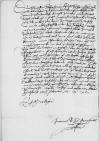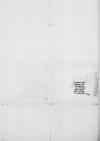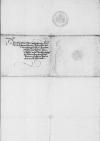Dem durchlauchten, hochgebornen fursten und herren, herren ⌊Albrechten⌋, von [Gots] [gna]den marggraff zu ⌊Branden[burg /]⌋, [in] ⌊[P]reussen⌋, / zu ⌊Stettin⌋, / ⌊Pom[mern]⌋, [der] ⌊Cassuben⌋ und ⌊Wenden⌋ hertzog, [burggraf] zu ⌊Normberg⌋ und furst [zu] ⌊[Rugen]⌋, unserm hochgunstigenn, [liebenn] [h]eren unnd freundt
Durchlauchterr, hochgebornerr furst, / hochgunstigerr, vilgeliebterr herr und freundt. / Mein freuntlich unnd gancz vleiswillige dienste zuvorann. /
Gestriges tags hab ich Ewer Furstlichen Durchlaucht ⌊⌋ entfangenn, do nebenn die brive in vorgenomenen sachenn an meinn altenn hoffbruderr, denn ⌊Nibschicz⌋, / welche ich mit andrenn meinenn morgenn frwe im wil zuschickenn, / zu Gote hoffende, das sie mit meynemm botenn wol und gewislich sollenn zwstelle komenn. / Mein schreibenn sol ouch, / wie ich imm negstenn gemelt, / an die II hern etc. ausghenn etc.
Vor das freuntlich entpittenn / der durchlauchten, hochgebornen Ewer Furstlichen Durchlaucht ⌊furstin⌋ und herczog Hansenn thue ich mich gen ire furstliche durchlaucht beyde uffs hochst bedanckenn / und bleib im vorigenn wunschenn, Goth den hochstenn bittende, Ewer und ire furstliche durchlauchten in seiner gnadenn / vor allemm argen, / und das seele unnd leib widrig ist, zu behuttenn und bewarenn, / und thue mich hiemit in Ewer Furstlichen Durchlaucht grosse und erkante gunst mith hochem vleis vortraulich befelenn, / der ich mich mit al meynemm vormugenn genczlich in aller freuntlicherr zuvorsicht / ergebe willig und gehorsamm.
Datum ⌊Heilsberg⌋, XXII Februarii M D XL.
Ewer Furstlichen Durchlaucht willigerr
⌊Ioannes⌋, etc. bischoff zu ⌊Ermeland⌋ etc. manu propria etc.



